Tartan: the fabric of a nation
Tartan: the fabric of a nation
Tartan and Scotland are inextricably connected and have strong associations which have been celebrated for hundreds of years. A special exhibition on tartan was on display at the V&A in Dundee exploring this connection, from its origins up to the present day. The exhibition included items on loan from the National Records of Scotland (NRS) and ran between 1 April 2023 to 14 January 2024. In this article we explore NRS collections further, to see what other threads of the story of tartan, can be teased out.
Origins
The earliest known example in Scotland of the checked cloth is known as the ‘Falkirk sett’. It dates from around the 3rd century AD and was woven using two different types of wool for colouration. The shepherd’s plaid (plaide in Gaelic meaning blanket), a piece of woven cloth in a simple checked pattern, was worn around the shoulders for warmth and had no connotations linking the wearer to a tribe or geographical location, being worn in both the Lowlands and the Highlands.
In North America, the terms tartan and plaid are often used interchangeably, but they have separate meanings. The Oxford Reference Dictionary cites plaid as being a ‘Chequered or tartan twilled cloth, typically made of wool’. Essentially, all tartans are plaids, but what makes plaid a tartan? It is its association with a particular social group or topographical area. The locally sourced materials and techniques handed down through the generations undoubtedly played a part in the design and tones of tartan making.
The origins of tartan are difficult to authoritatively place, but the Celts who inhabited Scotland’s Highlands and established the clan system were expert weavers, and may have had a hand in introducing the cloth. The Romans document that the Celts were skilled in the dyeing and weaving of wool, and that the Celts identified the ranking of individuals by the number of stripes worn on their clothing. The king’s attire, for instance, displayed seven stripes, whereas a peasant would wear one stripe (from 'The History of Tartan' by Iain Zaczek). One theory attests this was the stimulus for the creation of tartan. However, it should also be remembered that tartan reflected the materials, fabrics and other natural resources available to communities in a certain area, and therefore available to a clan based in that geographical region.
Tartan weave
As weaving techniques became more complex and natural dyes were introduced, the pattern or ‘sett’ (which refers to its structure by measuring the width of each stripe) of a tartan became more varied and colourful. The sett of a tartan is usually symmetrical and the sequence of its stripes are reversed around a central stripe, known as the pivot. The weaver goes about creating a tartan by preparing the warp (lengthwise threads) and then the weft (crosswise threads) on the loom.
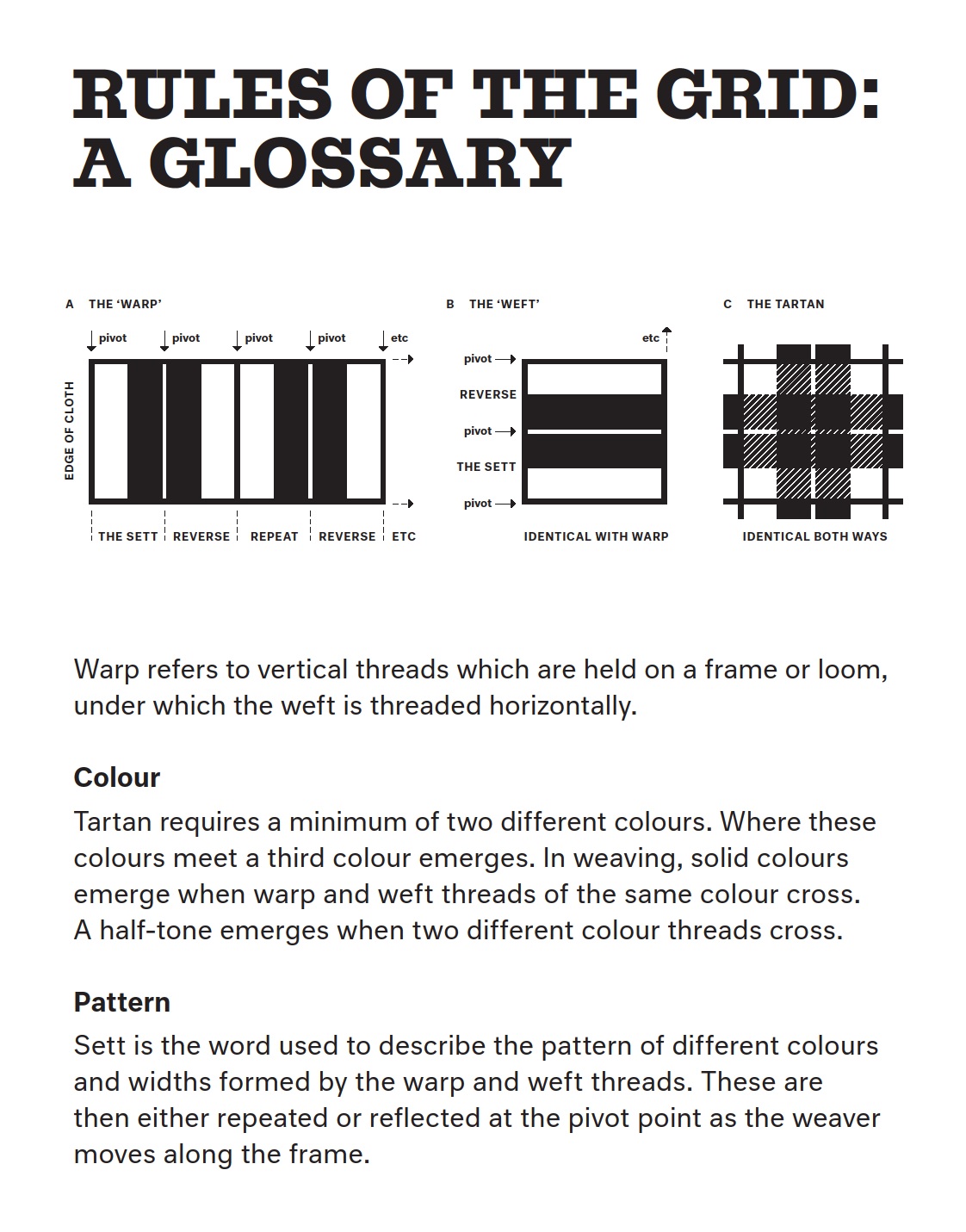
This straight forward guide to understanding the tartan pattern (from the Tartan exhibition at the Dundee V&A) separates the weft and the warp and how together they make the sett.
Rules of the Grid: A Glossary, 2023, V&A Dundee, graphic designed by David McKendrick Studio.
Natural dyes introduced a myriad of colours to the fabric, many of which were sourced from the surrounding landscape. Lichen, plants and even urine could be used to colour the spun wool from the local sheep herd. Many of the plants used for tartan dying feature in the NRS Archivists’ Garden. Some of these include: the root of the meadowsweet, birch leaves (dull yellow), and heather (yellows/orange). Traditionally the colour of tartans was fairly muted, but this changed with the introduction of synthetic dyes.
Tartan for all
Whole communities would be involved in the production of plaids or tartan, from shepherds, to spinners, and dyers to weavers. It was an occupation that included both men and women, and was worn by all.
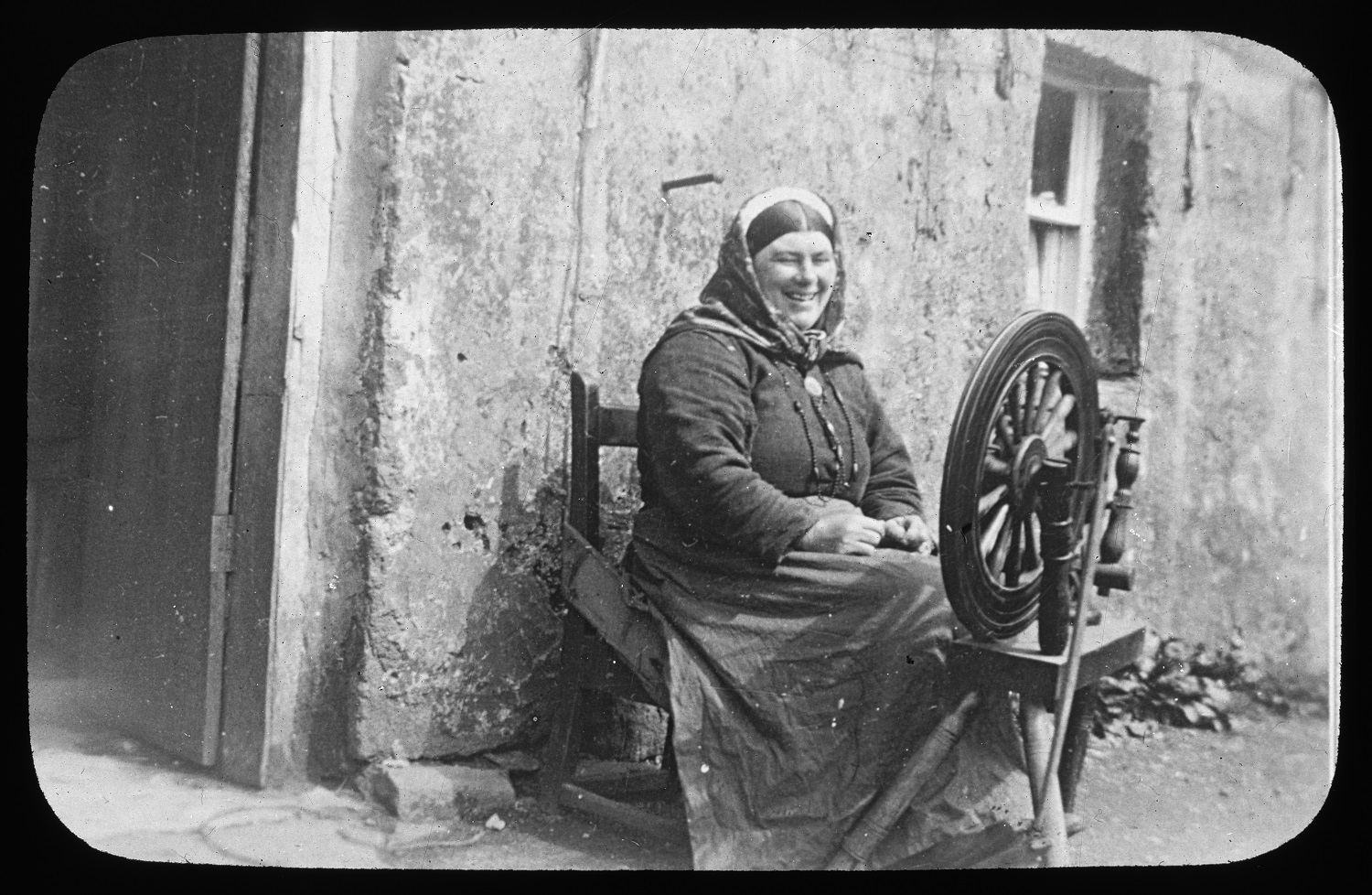
Happy at her work, a woman with a spinning wheel, St Kilda (no date)
National Records of Scotland, Lantern slides of St Kilda and the West Coast of Scotland, GD1/1488/57
It also appears that plaid and tartan clothing were worn by people of different economic groups. There is an account of a plaid being bought for King James IV in the Accounts of the Lord High Treasurer in 1512 (NRS, Crown Copyright, E21/10). The entry describes a plaid being bought while he was visiting Ayr, to be made into a coat.

Entry in the Lord High Treasurers Accounts for plaid
Transcription of entry: It[e]m the VI day of Maij for ane plaid to be the king ane coit. (Item 6th day of May for one plaid to by the king one coat)
Crown Copyright, National Records of Scotland, E21/10, 32r.
An entry within another Lord High Treasurer's Account of February, 1533, is thought to record the earliest mention of tartan: ‘Ane uthir tartane galcoit gevin to the king be the Maister Forbes’ ('Another tartan coat given to the king by the Master Forbes'. The phrase ‘uthir tartan coat’ suggests that a similar garment had already been given to the king. This can be found on the same page of the Treasurer’s Account volume (Crown Copyright, NRS, E21/26 f.16v) for the month of January 1533:

An entry in the Treasurer’s Accounts for ‘ane tartane galcot gevin to the Kings grace be the Maister Symple’ (Maister Symple is presumed to be Lord William Sempill, 2nd Lord Sempill (died 1552)).
Crown Copyright, National Records of Scotland, E21/26, 16v.
Tartan is power
Tartan has long been worn as a symbol of both unity and rebellion. In the seventeenth century, Highland clans were becoming isolated from the Lowlanders and wore their tartans as a show of unity. Lord Mungo Murray (1668–1700) is portrayed in a 1688 portrait by John Michael Wright wearing flamboyant Highland dress.
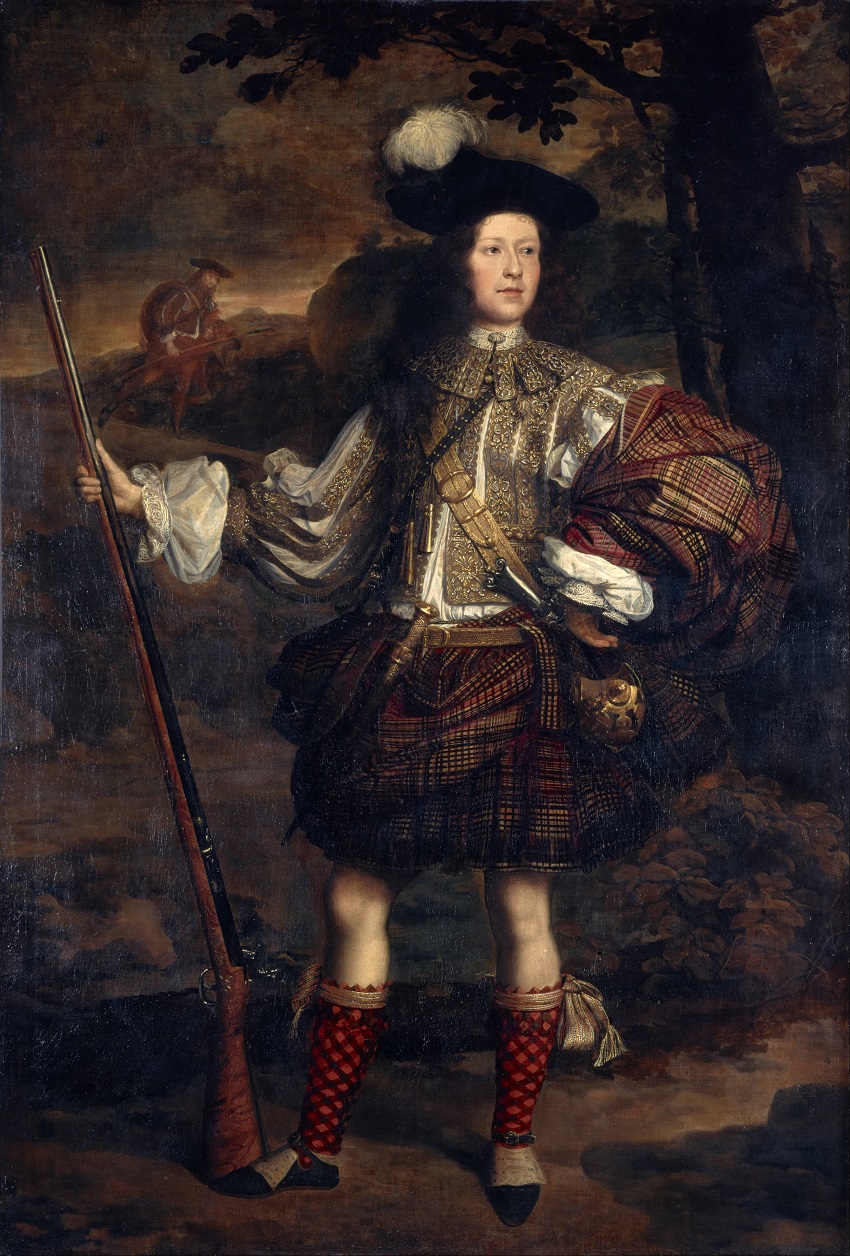
Lord Mungo Murray, by John Michael Wright, an early example of the full-length portrait in Highland dress (c.1683)
WikiCommons, public domain
Here the hunting version of his clan’s tartan is worn, along with the weaponry of his sport. The portrait depicts the 15-year-old as a powerful Highland chieftain, armed and ready for action.
Clans often adopted ‘dress’ and ‘hunting’ versions of their tartans, depending on the vibrancy of their usual tartans. Those who normally sported brightly coloured tartans considered unsuitable for hunting adopted a muted version. Dress tartans were designed to be ostentatious and worn on formal occasions. The tartan worn by Lord Mungo Murray in his portrait is recorded in The Scottish Register of Tartans along with thousands of others and one of the earliest known depictions of a ‘hunting’ tartan.
The Register was launched on 5 February 2009 after members of the Scottish Parliament voted to establish a single, independent Scottish register of tartans in order to promote and preserve information about historic and contemporary tartans from Scotland and throughout the world. This resulted in the enactment of the Scottish Register of Tartans Act 2008.
The Jacobite Rebellion of 1745 established tartan clothing as a patriotic fashion. Charles Edward Stuart (known as Bonnie Prince Charlie and also as the Young Pretender), who in his early appearances looked more like a church minister than a future leader, often wearing a ‘plain black coat with a plain shirt not very clean’ (Alexander MacDonald of Dalilea), realised the appeal of wearing tartan as a symbol of identity and power. He was seen on several occasions during the 1745 rebellion resplendent in tartan.
The Highland dress of the Jacobites and their white cockade (rosette or knot of ribbon worn as part of livery) was distinctive and identified them as supporters of Bonnie Prince Charlie. One inhabitant of Edinburgh wrote of the turmoil brought about by the rebellion in a letter to her child:
‘I must tell you I saw J. K. your old Play fellow, who has joined the Pretender, and got on highland Cloaths, and a white Cockade, which is their Livery. He said some rough Things, to which we said nothing; but I banter’d him a little for his Dress when he could not speak their Language; so he went off. But on the Saturday after our men were defeat thro the Cowardice and want of Conduct in that poor hurried Body Cope, I began to think we might not be so well used’.
(NRS, CH12/14/31, page 5, [no date])
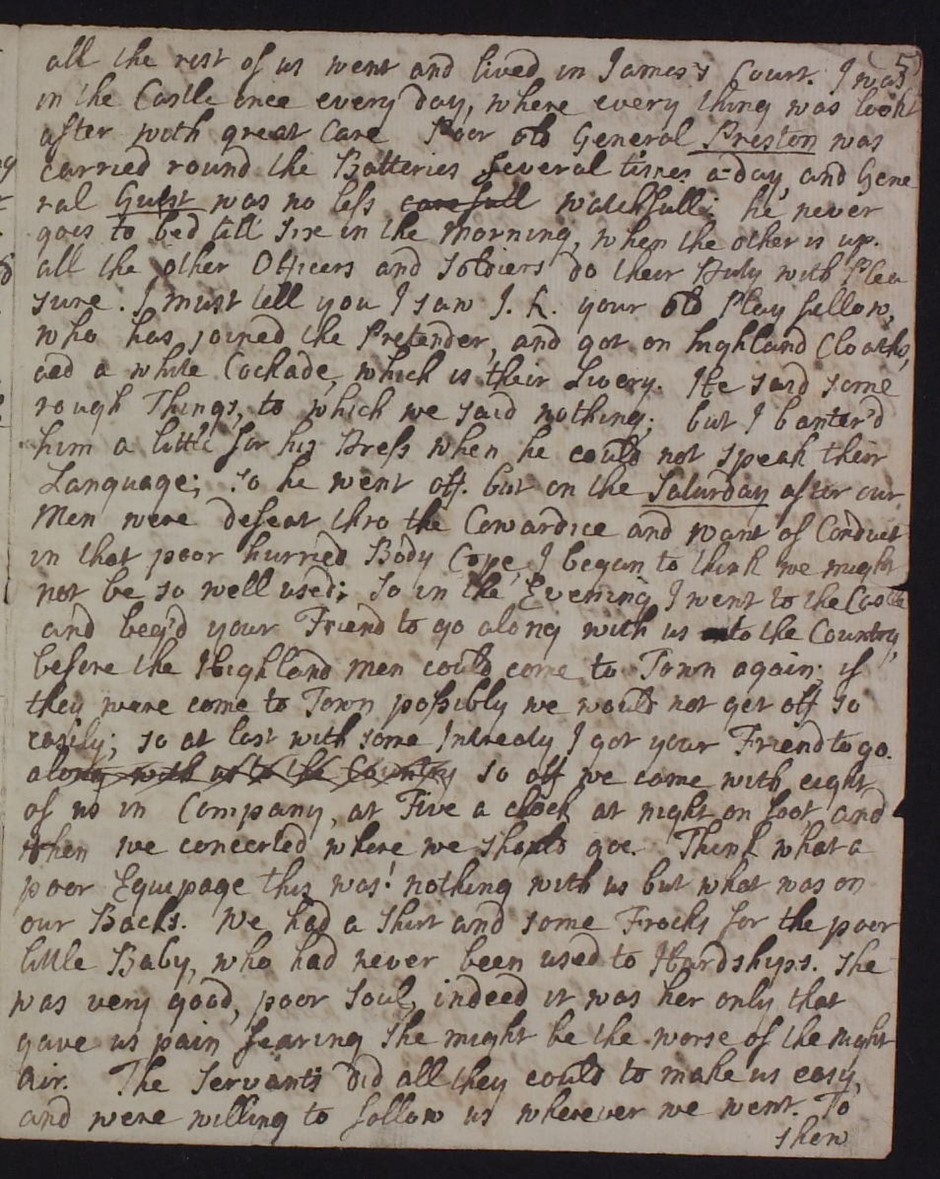
The letter, over several pages, details the mother’s flight from Edinburgh with the help of Jacobite supporters.
National Records of Scotland, Records collected by Bishop Alexander Jolly, CH12/14/31, page 5
Here the ‘highland Cloaths’ shielded the woman and her baby as they made their way from the capital to the relatively safety of the ‘countryside’ escorted by the Pretender’s supporters.
‘Highland garb’ banned
The Act of Proscription in 1747 was established to prevent further uprisings against the Crown. The act restricted the wearing of ‘highland garb and that no tartan, or partly-coloured plaid or stuff shall be used for great coats, or for upper coats; and if any such person shall presume, after the said first day of August, to wear or put on the aforesaid garments or any part of them’ and can be seen as a way of threatening the unity and identity of the Highlanders. The act is often incorrectly sited as banning the kilt, speaking Gaelic and the playing of bagpipes amongst other forms of Scottish identity. The punishment for wearing such ‘garb’ or Highland dress for men or boys was imprisonment and repeat offenders would be ‘transported to any of his Majesty’s plantations beyond the seas, there to remain for the space of seven years’ as stated in the 1747 Act.
In 1782, the ban was repealed, some 35 years after its inception. This was long enough for the skills required to create tartan and its complex patterns to be lost. Along with the implications of the Act and the Industrial Revolution, which brought about the Highland Clearances in the eighteenth and nineteenth centuries, the way of life of the Highlander was predominantly lost. Many of the crofters were forced off their land due to rising rents and sought work in factories processing wool in large cities.
Tartan resurgent
With the help of Sir Walter Scott’s “Waverley” novels and George IV’s visit to Scotland in 1822, tartan and the wearing of Highland dress became highly desirable and fashionable attire. A vivid description of the king’s apparel has been preserved in a letter written by Harriet Scott to her daughter, Anne, the day after George IV’s entry in to Edinburgh:
‘His Majesty wore the Royal Tartan Highland Dress with Buff coloured Trowsers like flesh to imitate His Royal Knees, and little Tartan bits of stockings, like other Highlanders, half up his Legs, and he looked very well only a little huffle buffle by all accounts.’
(NRS, GD157/2548)
The charming term ‘huffle buffle’ likely came from ‘Huffle-buff’, being a term for old clothes in Scots. David Wilkie’s flattering portrait, depicting the king at the entrance of the Palace of Holyroodhouse, wisely omits the stockings the king wore for the occasion.
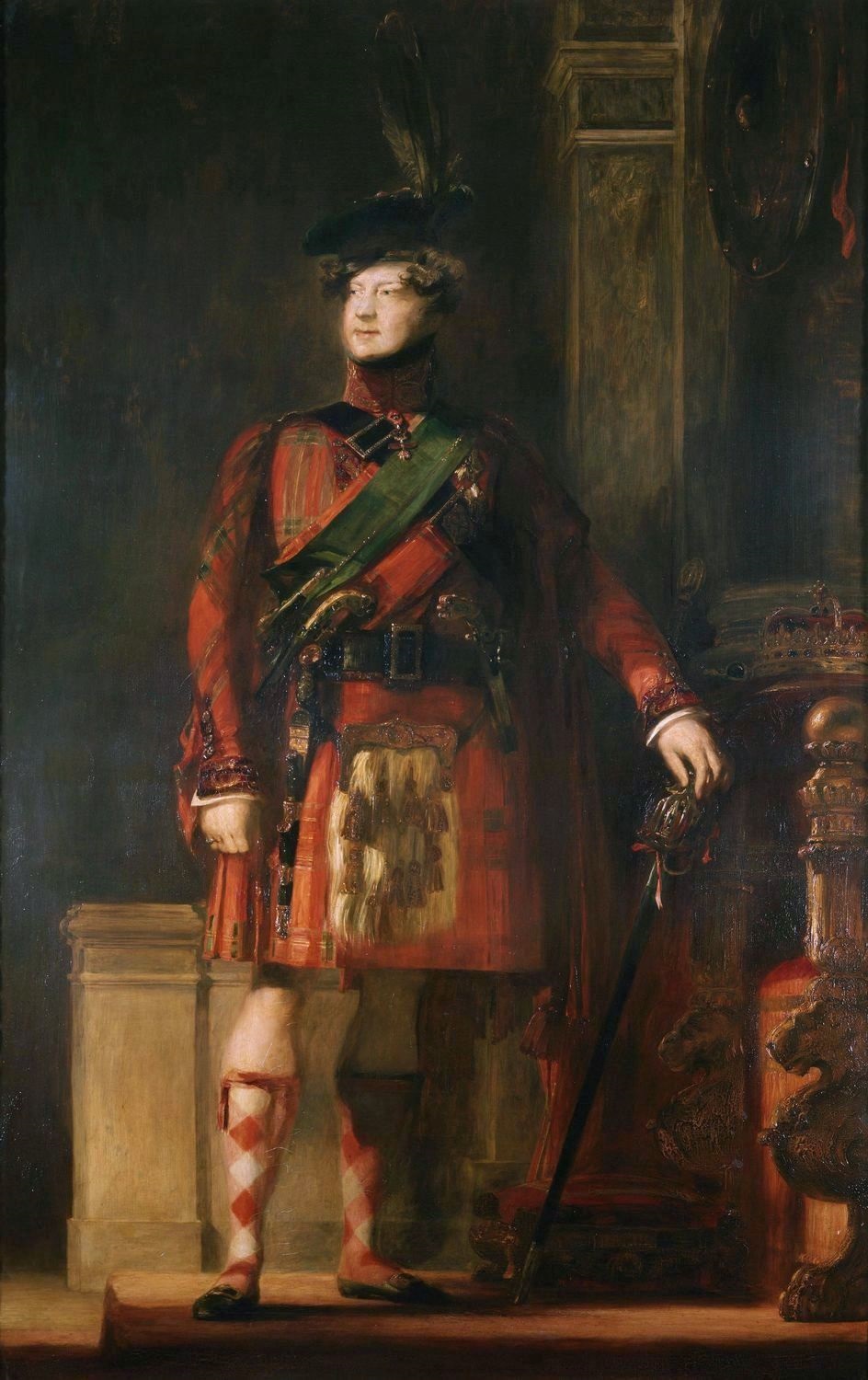
David Wilkie’s portrait of George IV on his visit to Scotland, 1822
WikiCommons (public domain)
Another great royal supporter of all things tartan was Queen Victoria. Her well-documented love of Scotland and its countryside helped to ameliorate the bad feeling left over from the Jacobite uprisings. Queen Victoria and her consort Prince Albert incorporated tartan into their own clothes and of their children. In September 1842, Queen Victoria and Prince Albert visited Scotland for the first time and resided with members of the Scottish nobility. Between 7 and 10 of September, they were the guests of Lord Breadalbane at Taymouth Castle, Perthshire. Eager to impress and please the queen, their host went to a great deal of effort to make their stay a memorable occasion. The guard of honour of 150 men were dressed in Highland dress:
‘no one thing could give greater […] or add more to the novelty and grandeur of the reception of Her Majesty, among the Highland Scenery at Taymouth, than the appearance of, a well organised body of Highlanders all armed, and uniformly equipped in the Clan Tartan; not to mention the propriety of the Great Highland Chieftan shewing before Royalty some small representation at least of what she has only read of in history, namely the Power of a Highland Chief, and the Devotion of his Clansmen.’
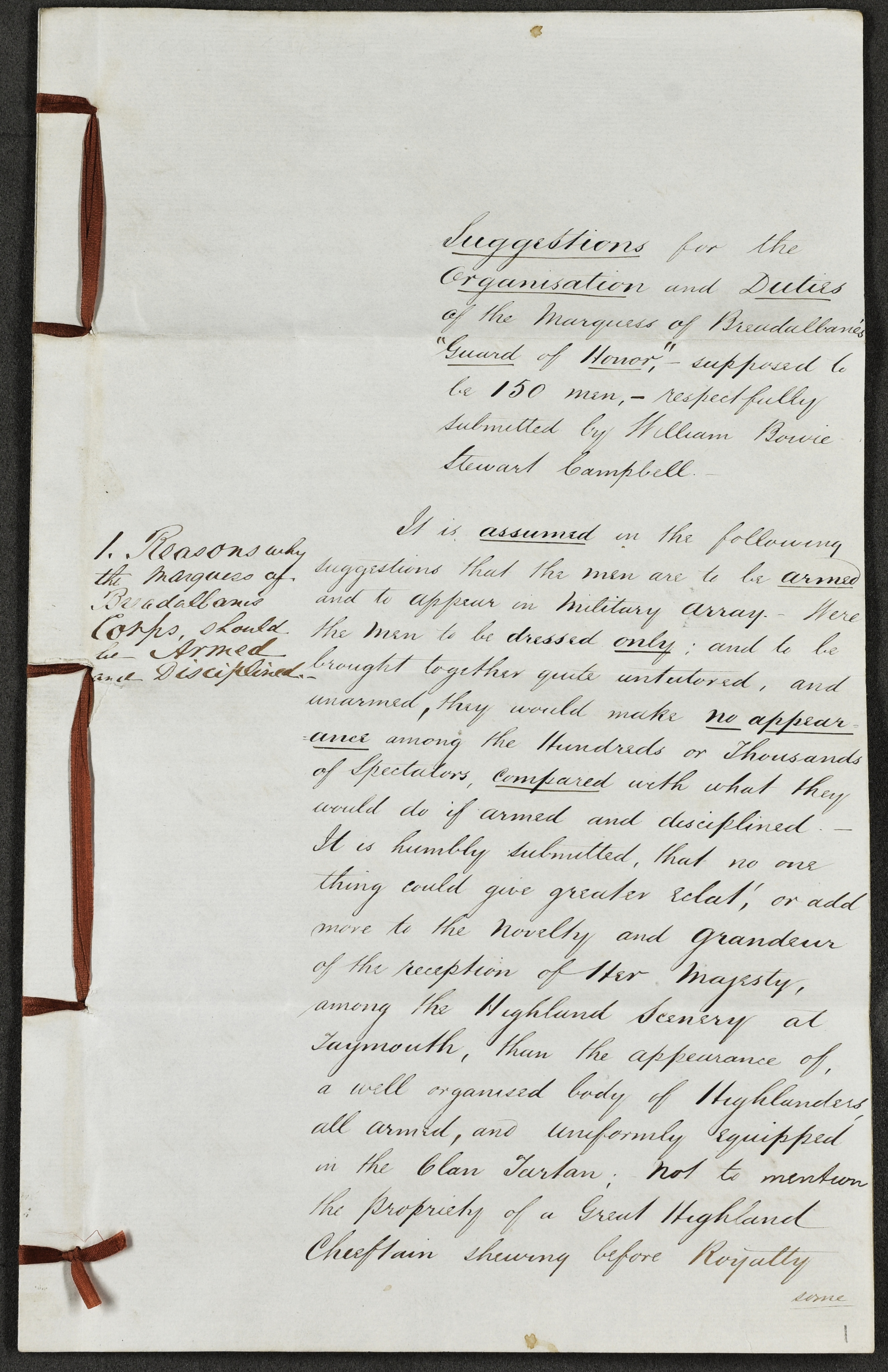
Plans for the Guard of Honour for receiving Queen Victoria and Prince Albert at Taymouth Castle, September 1842
National Records of Scotland, Papers of the Campbell Family, Earls of Breadalbane, GD112/50/5/4
Securing the vast reams of tartan for this event was not easy. One supplier, Romane and Paterson of Edinburgh, could not provide the ‘clan tartan’ required to outfit all of those attending. Instead, jackets made of green cloth had to be supplied, rather than of tartan. The women of the surrounding area were also invited and wore white dresses ‘with Tartan in scarfs or ribbons. 50 of Sir Neil Menzies’ tenants clad in their Tartan joined the rest in front of the house.’ (NRS, GD45/26/89 pp 2-5).
The young queen was delighted by the welcome party at Taymouth, and recorded in her diary:
‘At the gate we were met by a guard of Highlanders, L[or]d Breadalbane’s men…. L[or]d Breadalbane himself, was in Highland dress (all wear the Campbell Tartan) & stood at their head… Besides there was a company of the 92nd Highlanders. There was a great crowd, & the whole scene, with the firing of guns, to add to the impressiveness, was the finest sight imaginable, & and seemed like the reception in olden Feudal times, of the Sovereign by a Chieftain. It was truly princely romantic.’
(Diary of Queen Victoria, Volume 14, dated Wednesday 7th September 1842)
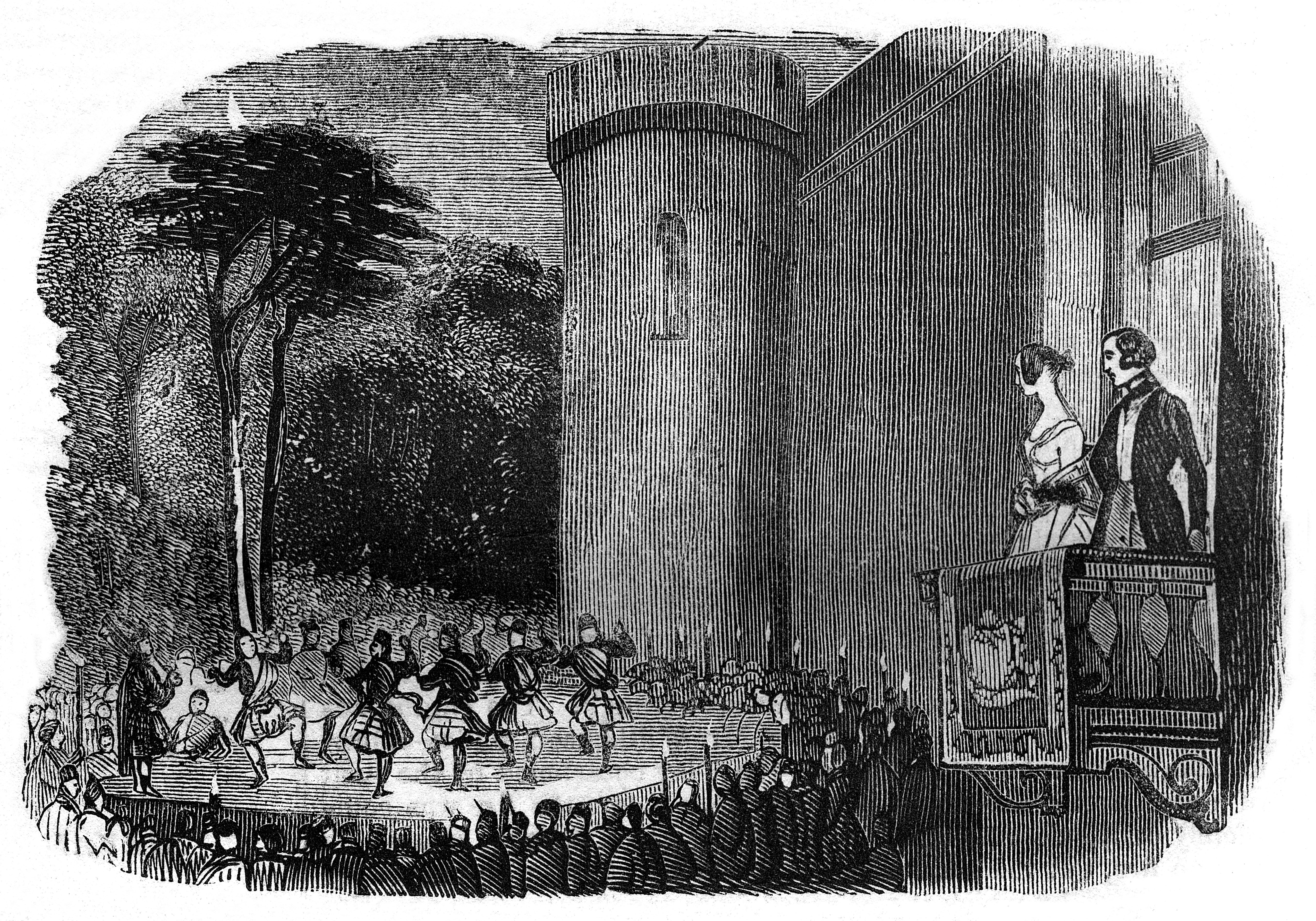
The Queen and Prince Albert watch the spectacle from a balcony at Taymouth Castle in 1842
With permission of © Illustrated London News Ltd/Mary Evans Picture Library
Tartan today
Tartan’s long and chequered past in Scotland is difficult to define, but it is clear that the fabric has come to characterize the land’s people and culture for centuries. Tartan is incorporated into the collections of today’s fashion designers, notably, Burberry and Alexander McQueen. The Highland dress (in varying degrees) is regularly worn at formal and informal events, such as at Hogmanay, weddings, ceilidhs, Highland Games, and quali (or qualy) dances. The tartan kilt is worn by sports fans (or the ‘Tartan Army’) at events across the globe as a symbol of national pride. The recent 2023 UCI Cycling World Championships held in Scotland registered a new tartan for the event, which includes the UCI’s rainbow stripe colours of blue, red, black, yellow and green. These are the same colours of the five Olympic rings, representing the five continents and proclaim the wearer as the international champion in their discipline.
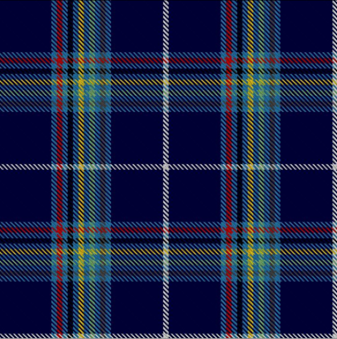
The Cycling world Championships tartan registered and features the rainbow jersey world championship colours
The Scottish Register of Tartans
National Tartan Day is celebrated across the globe and honours not just tartan, but the international contribution of Scottish heritage and culture. In 2016, when Humza Yousaf (now First Minister of Scotland) was sworn in as the MSP for Glasgow Pollock, as well as taking the oath in Urdu and English, he wore an outfit which combined his Scottish and Pakistani heritage. Yousaf proudly wore a traditional kilt with a sherwani jacket and has previously sported Scottish Islamic tartan. It would seem that tartan, originally used as a symbol of identification, is still used for that purpose today; but more than that, a celebration of the diverse population of Scotland. It is clear that tartan still plays a role in representing the pride of Scotland at home and away, and has a vibrant and meaningful future.